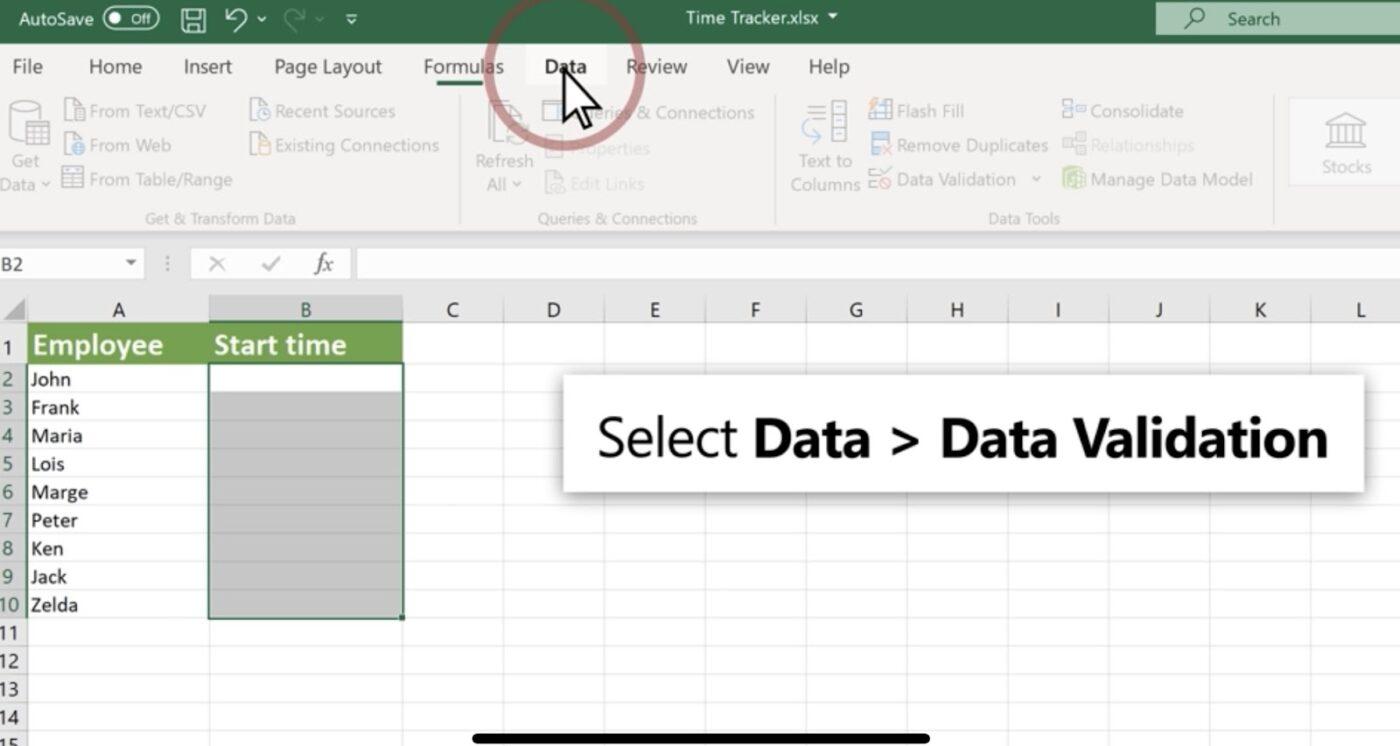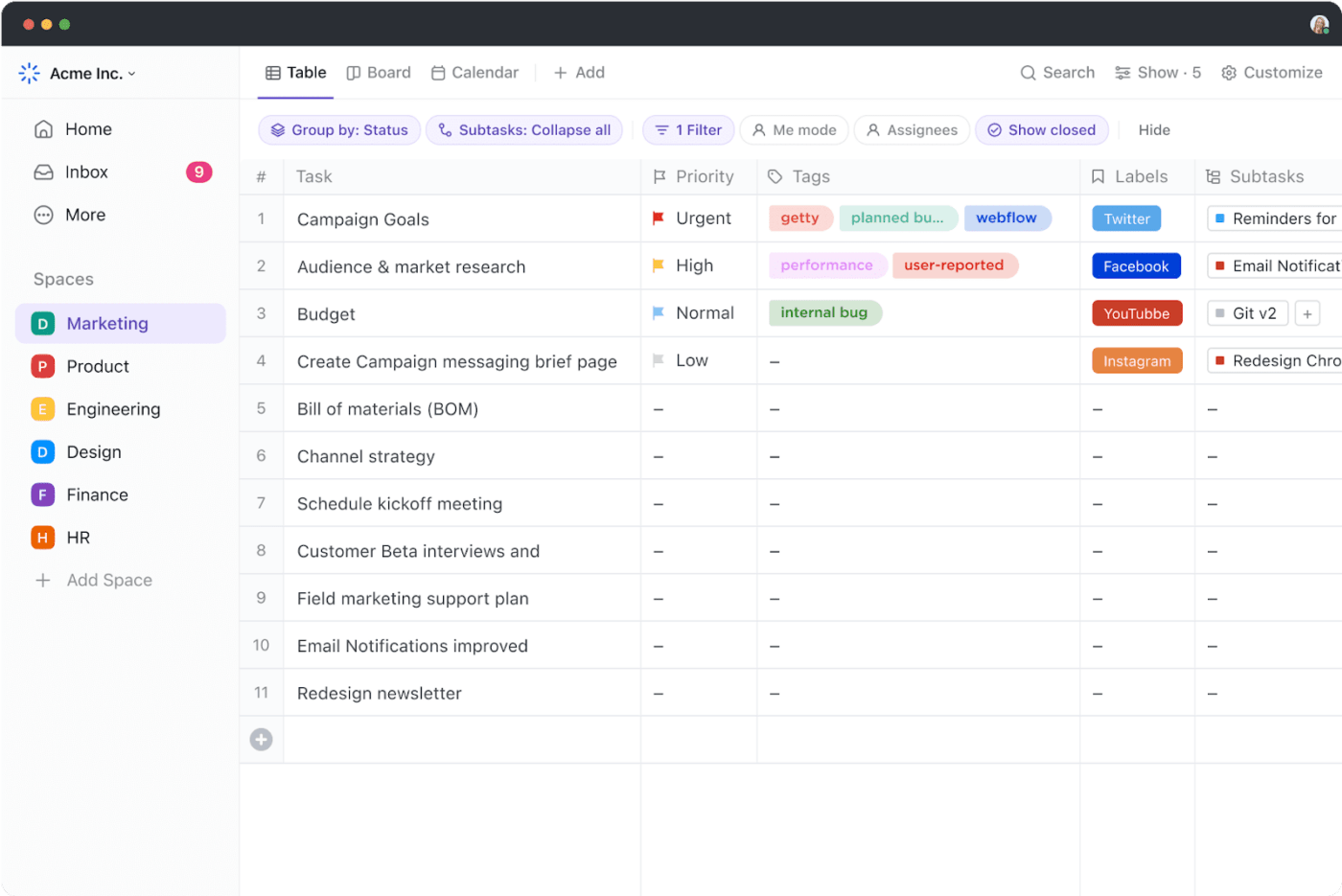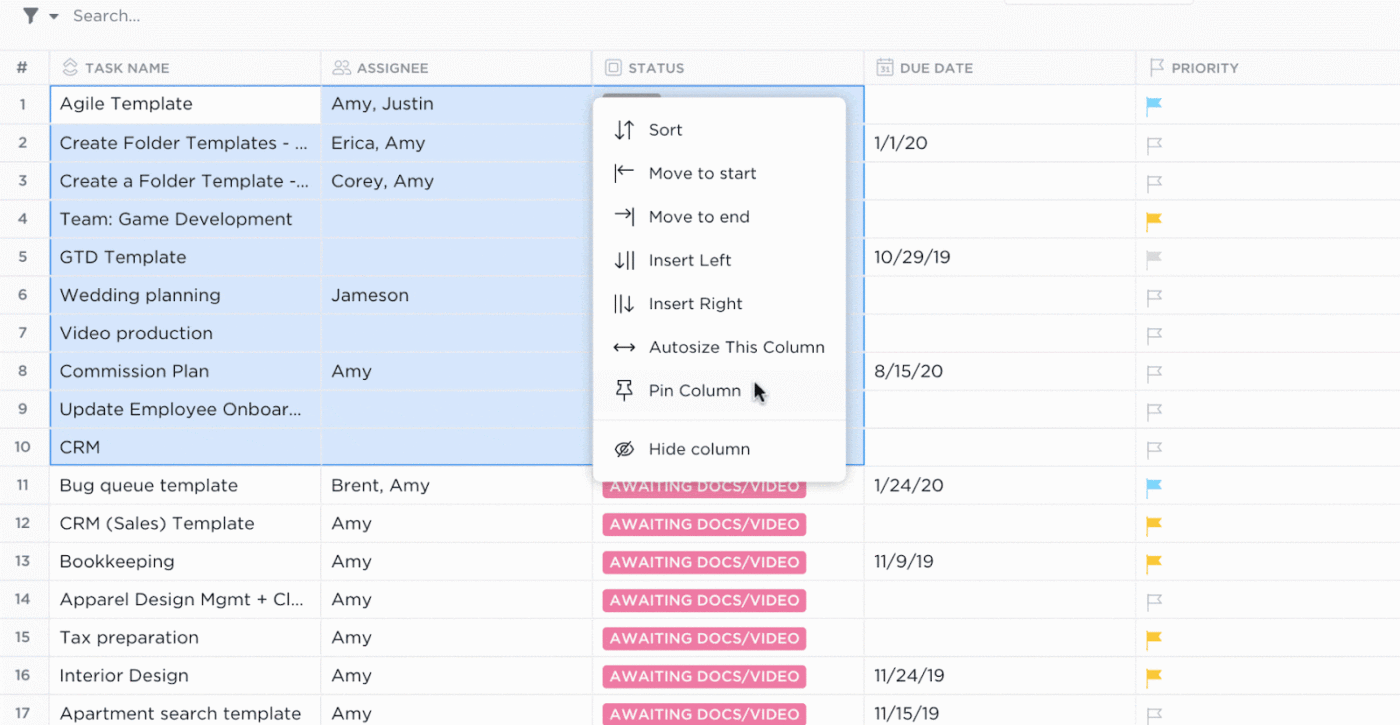How to Create a Project Plan in Excel

Sorry, there were no results found for “”
Sorry, there were no results found for “”
Sorry, there were no results found for “”
You’ve bagged a big project at work. However, your excitement is tinged with anxiety.
The end result is clear in your mind, but the path to get there? Not so much. How do you ensure every detail is covered and nothing falls through the cracks?
This is where project planning becomes your best ally. A well-carved-out project plan helps you allocate resources wisely, meet deadlines, and keep everyone on the same page.
And guess what? Chances are, you already have a powerful tool in your tech stack to execute this process: Microsoft Excel.
You might think of Excel as a spreadsheet software program, but you can also use it as a project management platform, especially if you’re just starting out. Excel allows you to design detailed project plans, organize tasks, track progress, and identify bottlenecks effectively.
In this post, we’ll show you how to create a project plan in Excel. And we’ll do you one better by introducing you to a far more user-friendly and scalable alternative!
Follow this step-by-step guide to make project planning quick and easy and drive successful project execution.
Before you outline your project plan in Excel, define your project goals and scope of work in detail. You can use your Excel sheet or any other notes app or documentation tool here.
This step sets the foundation for your project and ensures everyone involved clearly understands what needs to be accomplished. Here’s a more detailed breakdown:
Now, create a fresh MS Excel document. Here’s how you can populate the cells with details:
Add column headers in the second row of your table. Common headers might include Tasks, Assigned To, Start Date, End Date, Duration, Status, and similar categories. You can also bold the cells and fill them in with a color of your choice.

Fill the Task column with the tasks for your project plan. You can add as many or as few tasks as needed.

You’ve already listed down the tasks that are necessary to complete the project. Now, you’ll assign tasks to team members and add necessary comments, if any.
Follow this process:

However, you cannot automatically adjust resources based on project progress or dynamically allocate tasks among team members. You have to update the cells manually.
Excel doesn’t offer a built-in Gantt chart type, but you can create something similar by customizing a stacked bar chart and visualize the project timeline. Here’s how:



This will create a Gantt chart-like visualization.
Here’s how you can use Excel for project management:
Conditional formatting in Excel allows you to automatically format cells based on their values or specific criteria. The visual distinction helps you quickly identify critical tasks, track the project’s progress, and manage deadlines effectively.
For instance, you can color-code tasks based on their status (e.g., Assigned/In Progress, Pending, Completed) or priority levels (e.g., High, Medium, or Low).
To set this up, select the cells you want to format, go to the Home tab, click Conditional Formatting, and choose a formatting rule that suits your needs.

💈 Bonus: Here is a step-by-step guide on how to color code in Excel
Data validation and drop-down lists in Excel streamline data entry, ensure consistency across your project plan, and reduce errors. Creating drop-down lists provides some predefined options for team members to select from.
For example, you can set up a drop-down list for task statuses, such as In Progress and Completed.
To implement this:

PivotTables in Excel helps you analyze large data sets by creating interactive reports. Whether you want to track project milestones, generate summaries, analyze task completion rates, identify trends, or compare resource allocation, this feature does it all.
Here’s how you can create a PivotTable:

Apart from these features, you can create graphs in Excel to present raw data visually or make flowcharts in Excel to break down complex processes into simple, easy-to-follow steps.
Excel can be used for project management, but it might not be the best option if you’re looking for advanced features, scalability, and project lifecycle tracking.
After you create a project plan, you should have provisions to adjust the plan on the go, collaborate seamlessly, and track progress. In Excel, these tasks will require some manual effort.
Here are some tips for you to follow:
1. Communicate within Excel: Use Excel’s Insert Comment feature to leave notes or feedback on specific cells or tasks and communicate directly within the document
2. Leverage version history: Save versions of your project plan regularly to track changes over time. You can do this manually or by using Excel’s Version History feature if the workbook is stored in OneDrive or SharePoint
3. Maintain consistent formatting: Use consistent formats and styles for your data, such as color-coding and cell formatting
4. Use data validation: Implement data validation rules so the data entered into the workbook meets predefined criteria. It reduces errors and maintains data integrity
5. Provide training: Invest in employee training to make all team members familiar with Excel’s features and best practices for collaboration and improve overall efficiency
While you can list your tasks in Excel, it fails to meet your expectations from an effective project management tool. Here are some of its major drawbacks:
If you’re managing a small project as a solopreneur with minimal complexities and dependencies, Excel can be a good option. However, Excel will fall short if you’re scaling your business, looking to onboard more team members and clients, and want to design and visualize a detailed project plan. In such cases, you’ll need a comprehensive project management tool.
When looking for an alternative to Excel for project planning, be sure to check out ClickUp.
With this powerful project management tool by your side, mapping out a project plan is a breeze, no matter how large or complex your workflow is.
Let’s give you a glimpse into how you can create a project plan in ClickUp.
When creating a project plan, buy-in from both internal teams and external stakeholders is necessary. This step requires a clear communication channel to ensure everyone agrees on the project’s outline, scope, resources, timelines, and overall planning.
ClickUp’s Form View enables you to create customizable forms with conditional logic to capture relevant data. No more long email threads and unnecessary back-and-forth!
You can also turn the form responses into trackable tasks to fast-track the creation of the project plan.

Based on the information received, it’s time to outline the project’s goals, scope, timelines, and other relevant details.
You can use Clickup Docs here—a collaborative document where you can work in real time with stakeholders. You must document details such as project title, description, timeline, communication plan, and project objectives.

Once you’ve listed your project goals, the next step is to break them down into smaller bits and attach them to KPIs. ClickUp Goals proves useful here. This tool helps you divide big projects into manageable task targets.
Your team can take it one step at a time using ClickUp Tasks without feeling overwhelmed while tracking how their daily progress creates an impact.

Once you set the goals, break down each into multiple ClickUp Tasks. For each task, ClickUp allows you to:

And with that, your project plan is almost ready.
Designing the project plan isn’t enough. You should be able to visualize it in a way that works for you and your team. Why is it important? Visuals help you make sense of the project plan at a glance, keep a tab on progress, and understand how the different moving pieces of the project are connected.
Among its 15+ customizable views, you can use ClickUp’s Table View and Gantt View to stay on top of your project plan.
Table view in ClickUp lets you build a no-code visual database to store, manage, and control your project plan.
Here’s how you can add a Table View to your ClickUp Workspace (available for all plans):

The Table view is handy when you have a big project plan involving multiple goals, tasks, subtasks, dependencies, and fields. This feature empowers you to:

Sharing your Table view is seamless—use publicly shareable links to keep clients in the loop or let anyone else access your project. You can also export your data as spreadsheets for easy access or quickly copy and paste information into other spreadsheet tools.
ClickUp’s Gantt view lets you plan your project timeline, manage resources, and see task dependencies. It’s perfect for tracking project progress and resolving possible delays.
Follow these steps to add a Gantt view to your ClickUp Workspace:
Let’s consider a real-life scenario to understand how you can use theGantt view.
Assume your project plan changes midway, and you have to reschedule multiple tasks. With Gantt View, you can adjust your scheduled tasks’ start and due dates in bulk by moving an entire Space, Folder, or List. Just drag the progress bar left or right in Gantt view, and the schedules will shift everything accordingly.

The good news is that you don’t have to create a project plan from scratch (unless you want to!)—thanks to project plan templates. The ClickUp library has a bunch of them in store. Let’s check out a few:
Ideal for software development projects, ClickUp’s Example Project Plan Template simplifies the complex planning process and saves you time. The framework allows you to create a detailed project plan to organize tasks, phases, assignees, due dates, status, department, impact level, effort level, and more.
This template empowers you to:
For projects that span multiple phases and a long duration, having a solid framework is essential to keep the team focused. ClickUp’s Planning a Project Template is designed to help with that by tracking the project’s start date, due date, and overall project timeline, as well as showing the progress percentage of each task.
With a quick glance, you can spot any bottlenecks and take action—like reallocating resources to tasks nearing their deadlines but not progressing as expected.
| Feature | Excel | ClickUp |
| Task management | Basic task lists; limited to manual updates | Advanced task management with subtasks, multiple assignees, and priorities |
| Collaboration | Limited; changes are tracked manually, with basic commenting | Real-time collaboration, comments, mentions, and task assignments |
| Project tracking | Manual tracking with charts and formulas | Built-in project tracking with Gantt charts, Kanban boards, and timelines |
| Task dependencies | Not natively supported; requires manual workarounds | Powerful dependency management with three types of relationships: Waiting on, Blocking, and Linked Tasks |
| Reporting | Basic charts and graphs; custom reports require manual creation | Advanced reporting tools, customizable dashboards, and real-time analytics |
| User interface | Simple grid layout; can become cluttered with large data sets | Intuitive, user-friendly interface with customizable views (list, board, table, etc.) |
| Automation | Limited automation; relies on manual updates and macros | Extensive automation options for repetitive tasks and workflow optimization |
| Resource management | Basic; manual tracking and calculations | Advanced resource management, including workload and capacity planning |
| Accessibility | Primarily desktop-based; online collaboration is limited | Cloud-based with mobile app support, ensuring access from anywhere with real-time updates |
| Customization | Customizable with formulas and macros but limited in scope | Highly customizable with flexible views, custom fields, and task types |
Excel is a great starting point for project planning, especially for new project managers who need a simple and familiar tool to organize tasks and track progress.
However, Excel’s limitations become more apparent as projects grow in complexity and scale. At this stage, advanced customizations and features become essential. This is where a dedicated project management tool like ClickUp shines.
With advanced features, including task dependencies, real-time collaboration, detailed reporting, visualization, and project plan templates, ClickUp empowers you to handle evolving project demands, keeping your team on track.
© 2025 ClickUp